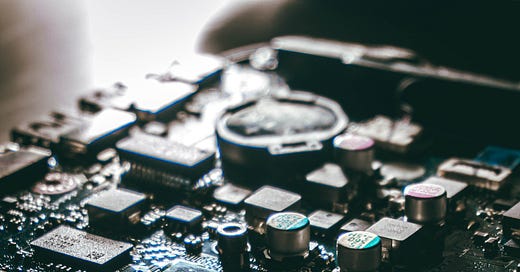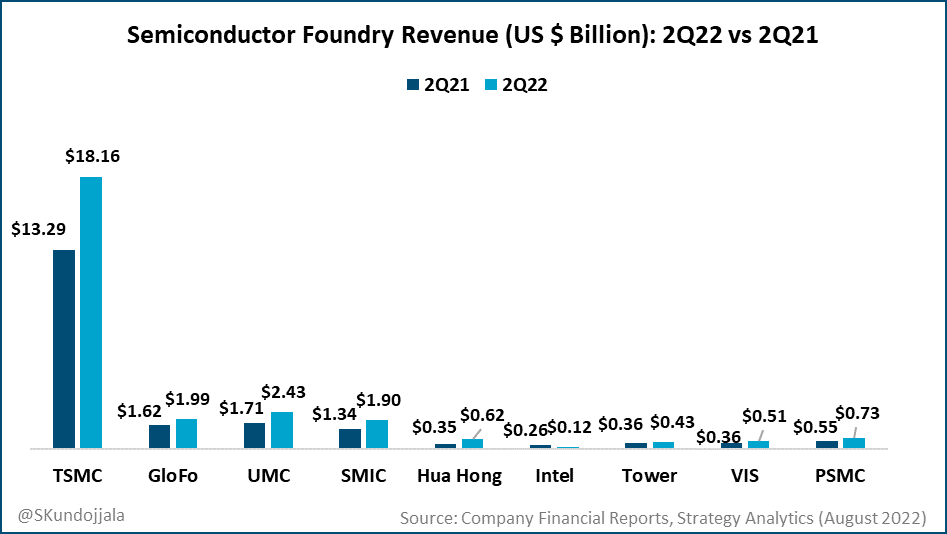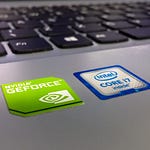Summary: In this special episode, we host tech/semiconductors analyst Eric Jhonsa to discuss key takeaways from earnings for the semiconductor industry. Eric writes columns for Real Money and live-blog earnings at The Street and was previously at Seeking Alpha focusing on tech news coverage, and a writer for The Motley Fool.
Editor’s Note: We have made available a transcript of this podcast, with relevant images and quotes, for ALL subscribers this week. Become a paid subscriber to support our work.
Show Notes
00:00:00: Introduction
00:01:32: Mapping the Industry
00:03:33: Industry Cycles
00:07:30: Takeaways from this Earnings Season
00:11:21: Semis’ Earnings Reports
00:15:33: Geopolitical Risks
00:17:21: Intel’s Turnaround Strategy
00:20:35: Recommended Resources
Episode Transcript
Introduction
[00:00:00] Mokaya: Welcome to a special edition of The Transcript podcast. We will be digging a little bit deeper into the semiconductor space. We're privileged to have Eric Jhonsa here who's a tech analyst who deals with the semis industry a lot. He tweets a lot, so you can find him on Twitter @EricJhonsa. He writes columns for Real Money and also for The Street. He writes a lot on Twitter, very engaging, especially in the areas of semis and tech generally. Welcome to our special podcast, Eric. I should get started maybe by asking you to tell us a little bit about yourself and what you do day-to-day.
[00:00:33] Eric: Sure. I've been writing about tech stocks for about 20 years. I handled tech news coverage for Seeking Alpha from 2012 to 2016. And then after that, I was the tech columnist for The Street and their subscription site, Real Money from 2016 to 2020. Since I started in 2021, I've spent a lot of my time trading and investing in tech stocks, but I still do a bit of writing. I still write a little bit for Real Money, and I also still do some earnings live blogs.
[00:00:59] Mokaya: What got you interested in the semiconductor space?
[00:01:02] Eric: It kind of gradually just formed. Writing columns in 2016, there was a lot of interest in the space and maybe wasn't covered as much, by other financial websites and maybe some of the bigger tech news sites. And so, I wrote a lot about Intel, AMD, and Nvidia, and just guess it drew a following. And I was also fortunate enough to interview some senior executives from some of these companies. So I think that helped out as well. It was just something I gradually got into, and just gained an interest in the space over time.
Mapping the Industry
[00:01:31] Mokaya: Interesting. And then for someone new to the industry, can you map up to us who are the key players in the industry? What does the semiconductor industry deal with generally?
[00:01:40] Eric: Okay. There are a whole bunch of different players, broken down into different fields. You can start with the IDMs, like traditional chip manufacturers, who both design and manufacture their own chips. You have companies like Intel, Texas Instruments, Analog Devices, STMicro, and Qorvo. Then you have the fabless semis, these are companies that design their own chips, but outsource manufacturing to foundries, like TSMC. These are companies like Nvidia, AMD, Qualcomm, Marvell, and Mediatek. Then you have the memory makers, the big three there are Micron, Samsung, and SK Hynix, though NAND memory also has some other players like Western Digital, Kioxia, and in China, YMTC. Then you have the foundries, the contract manufacturers of chips. TSMC is by far the biggest one, they have a 50% plus market share, but then you also have various other players, such as Global Foundries, Samsung, UMC, and SMIC. Then you have the chip equipment makers. You have just companies supplying first on the front end, like equipment for wafer fabrication, like Applied Materials, KLA, ASML, Lam Research, and Tokyo Electron. Then you also have some companies that provide equipment for assembly and test, like Teradyne. Then you have the OSATs, the companies that do outsourcing for assembly and test, which are like Amkor, ASE, and ChipMOS. And then finally, you got EDA software firms, which are the companies that provide software for doing chip design. Cadence and Synopsys are two big ones. Siemens is also a player there.
[00:03:06] Mokaya: That's a very interesting mapping of the industry as a whole. Some of the key players which I follow are AMD and TSMC because they're pretty huge. Global Foundries and Intel, obviously, because they're on a kind of transformation journey from having lagged the industry for a while and now trying to become the leader in the industry. Of all these companies, one of the themes that have come out, especially during this earning season, is that they have excess inventory.
[00:03:30] Eric: Some of them do. It depends on the company. I think it depends on the products.
Industry Cycles
[00:03:33] Mokaya: Yeah. It differs definitely from company to company. But generally, the question I had, maybe map out for us, what's the typical cycle for a semiconductor industry player in terms of at what point they have excess inventory, and when they have little inventory. Does that ever balance out in the cycle of a business?
[00:03:51] Eric: Yeah. In a traditional cycle, I guess you have up cycles and down cycles. And I guess when an upcycle is kicking off, customers' inventories and distributor inventories are fairly low. And these customers are finally seeing an uptake in demand, and that higher demand leads them to place larger orders, and try to replenish their inventories. And that in turn leads lead times for fulfilling these orders to start growing. That kind of creates a virtuous cycle for a little while where there are longer lead times, there’s higher demand, and this inventory replenishment will then lead the chip developers to place large orders with foundries. Or if they’re IDMs, to increase their CapEx.
The foundries, when they get large orders, start increasing their CapEx and invest more to provide more supply. And that goes on for a while. And when demand finally starts slowing for the end customers, and maybe also when the lead time starts contracting, just because there's now more supply, these customers will then start cutting their orders and they'll start cutting back on their inventory. And that's when the downcycle typically starts.
[00:04:53] Mokaya: As you said, different companies are also at different stages. I know especially the ones that are very exposed to the consumer goods section have excess inventories, that's what they've been reporting this past quarter. Are semiconductors not interchangeable in a way that you can switch them from auto to consumer goods? Because I know auto companies say they still have inventory shortages in the areas of semiconductors, but then those who are exposed to the consumer goods industry are saying that they do have excess inventory. What's your take? And what's your feel around the industry currently on where we are in the business cycle?
[00:05:23] Eric: It's very complex, I think sometimes people try to oversimplify and they say, everything's great. There's still a ton of demand for chips. Just buy everything. Or on the flip side, they'll just say, we're going into a massive down cycle. And every chip supplier is going to get crushed and you’re going to see giant inventory corrections. And I think the truth is in between. For a lot of consumer products – like you were saying, for PCs, smartphones, more low-end smartphones, high-end, graphics cards, for home electronics, there is weakening demand, certainly. And it's continuing, it looks like, it's going to continue into the back half of this year. And you have seen like a lot of the end customers, the OEMs, start to cut their inventories because of that. And that's probably going to continue for a little while. You go into other markets, and in some places, I think you're starting to see inventory corrections because you did see OEMs build up inventories over the last two years, thanks to the pandemic causing the supply chain disruptions. And also just because of demand spiking, companies wanting to play it safe and build up inventory. So you do have some here and there, but it really depends on the product, it depends on the end market. You have memory makers, like Micron saying, they're seeing broadening inventory corrections. And it's not just consumer products for them. They're seeing, like, server OEMs cut inventories. And Micron suggested there were some initial inventory cuts even among auto and industrial customers. But other major suppliers to the auto and industrial firms, like NXP, Onsemi, Microchip, and STMicro, suggest their demand is still pretty good and that their channel inventories are still pretty low, that they're below historical levels. Some of them have said some of their customers are carrying higher normal inventories. But they're also saying others still have major shortages of supplies, and a couple of them have basically said they're trying to shift some of the supply from companies that do have some excess inventory to companies that are still dealing with shortages, that need more inventory. So it's far from an awful situation for them. And it seems like their lead times for many of their products are still pretty elevated. They're still much higher than usual. Eventually, those lead times will come down, but it’s not a bad situation really for them.
Takeaways from this Earnings Season
[00:07:30] Mokaya: So perhaps looking out at some of the key takeaways that you've taken from earnings this season apart from the fact that some of them are challenged in terms of having excess inventory and others are not, are there any other, maybe things that stood out for you as you looked at the various companies? I know GlobalFoundries were reporting this week, and some of them are still reporting. I think one of the things that you tweeted out today was about lead times, still quite pretty high. They've been revised downwards, by 27 to 26.9 weeks, but that's very small. So are there others that stood out for you in the earning season for the various companies in the semi-industry?
[00:08:05] Eric: A few different things. Obviously, just as you mentioned, the consumer weakness, it's more pronounced in certain consumer products than others. Certainly, gaming GPUs are pretty weak right now. I’m sure you saw Nvidia’s warning. It reminds me a little bit of early 2019 when you all had a major inventory correction among the graphics card OEMs after there was a giant surge in demand from crypto miners. You've got…this time, maybe the crypto impact isn't quite as big. It is there again, but you just had a surge in gaming GPU demand over the last couple of years, and you're now seeing some contraction. Also, you've got new gaming GPUs coming out later this year, so some people might want to hold off on their purchases until new ones come out. So, that was one thing, On the other hand, the strength of high-end smartphones was a little surprising. Apple reported a fairly good quarter, they were indicating their demand still isn't bad. And their chip suppliers have also suggested – they usually can't mention Apple by name, but they've suggested our biggest customer, our top high-end smartphone customer, which is like code for Apple – they're saying they're still seeing good demand. So that was a positive surprise. I guess the other thing is just how much cloud demand is holding up well, at least in the US. There's some softening in cloud CapEx in China, but the US hyper scalers, like Amazon, Meta, Microsoft, and Google, they’re still investing a ton in CapEx and it looks like that's going to continue into 2023. So that was definitely a strong point. I guess one other thing is – you saw Micron’s warning – memory is maybe the weakest area right now, or one of them. Just because it's not just about lower volumes because of the consumer exposure, because of the smartphone and PC exposure. It's also because these companies sell commodity products, to a large extent. When volumes drop, when demand falls short of supply, you see prices drop. That's causing major issues, and it's causing these companies to rethink their CapEx spending. So I think those are the big things for me.
[00:09:57] Mokaya: All right. And perhaps in terms of outlook, I can sense that you are a bit positive about some of these companies. Anything that you've seen there in terms of valuations? Are they challenged? How are they doing in the semi-industry overall?
[00:10:07] Eric: I think a lot of the valuations are reasonable. You can find a handful that is still kind of expensive, but if you look at a lot of these analog and MCU suppliers that have high auto and industrial exposure, a lot of them still trade for maybe 12 to 15, 16 times forward earnings. They're not exorbitant valuations by any means. And I guess skeptics might argue that some of these estimates might need to get cut because you see inventory corrections and so on. But even if they're ultimately trading at 17 to 19 times forward earnings, if for next year – if that's trough cycle earnings, if that's the bottom of the cycle and they're still only at a P/E of 17 or 19 or 20 – that's not bad at all. And the same thing I'd say [about] a lot of the chip equipment makers like Applied, KLA, and so on. They've got very similar forward P/Es, sometimes it's like 12 or 13 times forward earnings, around there. And it's very reasonable, even if you do assume some estimate cuts because of weakening memory CAPEX, you still have a pretty strong demand environment for CapEx among foundry and logic manufacturers. So even if you assume those estimates get cut a bit, and those forward P/Es increase a bit, these aren't crazy valuations by any means right now.
Semis’ Earnings Reports
[00:11:21] Mokaya: So in terms of reading the earnings call for some of these companies, for someone who's new to the semis industry, what are some of the things they should be looking out for, especially in this season? You’ve got to pay attention to what they're talking about in terms of inventories, in terms of outlook, in terms of demand. But when you sit down with an earnings call transcript or an earnings call report from one of these semiconductor industry players, what are some of the things that draw your attention very quickly?
[00:11:45] Eric: It depends. Certainly, just see any commentary about the supply-demand balance, about where they see supply catching up with demand, that's definitely true for a lot of these like analog and MCU names, and for the foundries too. Just paying attention to that. Then any commentary about demand in different end-markets, whether they're still seeing strength, whether they're seeing weakness. How things are in automotive, how they are industrial compared with how they're in consumer end-markets. So a lot of that. Commentary about channel inventories, just how much inventory distributors are holding, and has that gotten elevated? For a lot of companies, it's still fairly low, though, for a couple of companies, it's gone up recently. And then also on CapEx plans. In an environment like this, where companies have been trying to catch up with demand for a while, they've been investing heavily in CapEx, and just seeing how that's trending, which matters obviously directly for the chip manufacturers. And then also of course…it matters for the equipment suppliers. So it's a bunch of different things to look at.
[00:12:44] Mokaya: Another question that I had is about the OEMs and how the outlook is in terms of inventory. I know you've touched on it a little bit, but are OEMs likely to have excess inventory compared to the other inventory that they have on the balance sheet? Have you seen any signs of that? Because from the earnings calls that we're reading so far, the OEMs still say that they have huge chip shortages. There's still demand for cars, and they still can't have enough. And I think for the last year they were mostly making premium-end cars, which were fetching a bit more money. What's the feel you get from the OEMs this quarter?
[00:13:14] Eric: I think it depends on the kind of OEM. For the automakers, certainly, a lot of them are saying there are still supply-constrained. They're still dealing with shortages. Some of them have built up inventories for certain chips, but it varies again from one chip to another. And one thing I bring up here with this, with concerns about double-ordering and stockpiling is it tends to happen more for cheaper chips. It might happen for a cheap MCU or power management chip or whatever. But OEMs, whether in auto or elsewhere, are less likely to significantly stockpile inventories for more expensive chips. Broadcom’s CEO brought that up before. And so I guess with the auto OEMs like you're saying, there's still vehicle shortages. And the automakers have been prioritizing costly vehicles in an environment like this – these higher margins, higher ASP vehicles. And that naturally increases the amount of chip content that goes in. And you also just have secular trends driving higher auto semi consumption, in terms of EV adoption, ADAS adoption, more powerful infotainment systems, and digital instrument clusters. So all of that's been driving consumption.
And then also just from a revenue standpoint for the chip suppliers, prices have been going up. Some of this is due to inflationary stuff. Some of this is due to the supply-demand balance. It's for a variety of reasons that prices have gone higher. So you have a bunch of factors that have been driving up auto semi sales that don't necessarily stem from hiring, from large inventory builds. Though, again, for certain products, you might have some inventory going up. Outside of auto, I think if you look at enterprise hardware OEMs, and PC OEMs, they have increased their inventories. if you look at their balance sheets, it's not often by a crazy amount. If you do some back-of-the-envelope math, it looks like a lot of these OEMs might carry an extra month or so of inventory on average for a lot of products. So, if they pare back their inventory back to normal levels, it's not necessarily the end of the world for the chip suppliers, just as long as end demand doesn't fall sharply at the same time. So yeah, a lot of OEMs do have some excess inventory, certainly, for various reasons. Some got nervous just because of the supply chain disruptions, and maybe some of them just decided to double order because you have had this supply-demand imbalance for the last couple of years. But at the same time, it's not always a crazy amount. And again, it varies from product to product. Some products might have stockpiled a lot of chips whereas others are still dealing with shortages.
Geopolitical Risks
[00:15:33] Mokaya: A quick one especially in terms of TSMC and the important role that they play within the semi-space. Lately, there have been a lot of geopolitical risks. I think the situation in Ukraine has opened a lot of countries' eyes to the risks that are inherent in globalization. They're trying to kind of scale back on that, and I think one key issue is obviously TSMC and their recent issues, let's say with China, the US, and the US with Intel and all of these geopolitical risks around this space. What's your feel around geopolitical risk in the semiconductor space currently and perhaps going forward?
[00:16:09] Eric: Certainly it's on the minds of politicians, they want to localize supply chains more, Completely localizing things is unrealistic. The idea that you're going to have Apple, AMD, and Qualcomm someday just going to get everything from the US and not have anything manufactured in Taiwan or anywhere else out of the US, that's not realistic, but they want more security in the supply chains. They want to make sure that in a worst-case scenario, you can still manufacture these chips in the US. And, certainly, you saw the Chips Act. And you also have other countries creating their own subsidies. The EU is also offering subsidies, and it's happening in other parts of the world. And I think that'll continue. And that's certainly a tailwind for chip CapEx, for fab equipment spend, just like all the new fabs that are getting built. Like TSMC is building a new fab in Phoenix, Intel is building a couple of new fabs nearby, and Samsung is building a big one in Texas. And a lot of this is with the help of subsidies. And so I think that effort to create more redundancy in supply chains, to make them just in a worst case scenario, you can have a lot of manufacturing done locally if necessary. I think that trend will continue. But at the same time, it won't be like everything's going to be shifted over to one country, everything's going to be localized. It's more like a fail-safe mechanism.
Intel’s Turnaround Strategy
[00:17:21] Mokaya: And then speaking of Intel, how are they in terms of their turnaround strategy and the outlook? I think you mentioned to me before we hit record, that 2024 would be a key year for them. Why do you think so?
[00:17:34] Eric: Intel is really in a rough spot right now. Their Q2 report was pretty bad. Their guidance was really, really bad. It took a lot of people by surprise, just how much they're struggling right now. A lot of it's due to their manufacturing issues, how their next-gen process, which I guess they now call Intel 4, will be pushed out. And they're losing a lot of CPU share to AMD and also the Arm CPU developers. And so 2024 could be a big year because they have an ambitious manufacturing technology roadmap. And if they can make good on that roadmap in 2024, they could be ahead of TSMC in terms of process technology. They're supposed to start volume production of a next-gen process called 20A in the first half of 2024. In the second half of 2024, they say they're going to start production of a successor process called 18A. And those processes, if they ramp on time, will be more advanced than what TSMC expects to have at that point. TSMC is going to start volume production of a process called N2 in the second half of 2025. Which from the looks of things, might be competitive with 20A. So. if Intel pulls this off, they have a lead. But it's a big if right now, just because they've had so many execution issues. They've really just struggled to make good on their manufacturing promises in recent years. So, there are a lot of unknowns right now. And [2024 is] really a make-or-break year for them because if they don't make good on this roadmap, then they're really going to be in a tough spot, just given how much market share they've been losing and will probably continue losing in the next year to AMD and to various Arm CPU developers.
[00:19:10] Mokaya: In terms of AMD versus Intel, you tweeted a while back about the trends in the margins. Could you reiterate what you talked about there?
[00:19:17] Eric: Yeah. If you dial back the clock a few years, Intel's gross margin was far above AMD's. Intel’s GMs were in the sixties, AMD’s were in the mid-thirties, and now the shoe is on the other foot. AMD's gross margin is in the mid-fifties. They got a bit of a boost from the Xilinx acquisition, but even without that, you would probably be around 50% or so. And now Intel's margins have actually fallen into the forties. And some of this is due to Intel's volume pressures, due to some of their execution issues. Some of it's also just due to Intel's decision to significantly increase their CapEx, which drives up their depreciation expenses. Intel's really betting the firm on this manufacturing strategy of catching up with TSMC manufacturing-wise and also becoming a major foundry player, investing a ton of CapEx along the way. And in the short-term, there's a clear margin hit there. And on the flip side, AMD has really moved upmarket. Their server CPU sales have really taken off. These are high-margin products. And then even in the PC CPU market, their sales mix has really shifted towards more expensive PCs, towards mid-range and high-end PCs. And that's very different than what was the case five or six years ago when their sales really skewed more towards the low-end. And then you combine that with just their greater scale at this point, the operating leverage that comes with that, I think that's also helped out with their margin profile.
Recommended Resources
[00:20:35] Mokaya: All right. In closing, perhaps I would want to ask maybe two final questions. So one is which kind of resources would you recommend to someone who's interested more in this space to look out for? Some of the newsletters or some of the books that you are reading or perhaps your columns, so people can find you but you can also tell us a little bit about something that is very interesting that you've learned that surprised you by learning or by looking around into the semiconductor space. So what's the most interesting story or any interesting fact that you've learned by engaging in this space for a while?
[00:21:09] Eric: That's kind of a tough question. I'm not sure if there's one thing I guess that would really pop out. I mean, just learning how many different steps go into manufacturing a chip, and how many different processes there are. You have hundreds of different things and steps. It's fascinating in a way, it's almost like magic when you think of all these different steps, all these different technologies that get deployed, how precise everything has to be, how pristine air quality has to be. And it drives home why manufacturing at the leading edge is so difficult, why a company like Intel has had some of the challenges they've had, and why TSMC has become so dominant. Why no one else has really been able to keep up with them? And so that's what really been interesting to me. Just from the technical side, the challenges, and how much it keeps getting more and more complex. It's not getting any easier, as new leading-edge processes come out, and the transistors get smaller and smaller.
In terms of resources, there are a lot of great websites. I feel like there are also a lot of great Twitter follows. I feel like a lot of [these] people really follow semis closely. There are a lot of trade journals. I would say a site like the Next Platform or Semi-engineering or, SemiWiki, sites like that are worth just checking out to try to get some more information from the people who are interested in the space. EE Times I guess would be another one. Digitimes, I feel sometimes, you know, they're a little hit and miss sometimes with their reporting. But I think it's worth just following, sometimes their supply chain scoops are useful. There are a lot of different websites that people can check out. And certainly, I think Twitter is also very useful. There are some very smart people on Twitter who are often tweeting about semis. Who really just has a finger on the pulse of the space.
[00:22:45] Mokaya: I think those are great resources that you've mentioned. I would say for me, what stood out in terms of learning in the semiconductor space, I was impressed by this one picture that was doing rounds on Twitter a while back about how many semiconductor chips are in the modern car compared to previously. That stood out for me. I didn't know chips were that essential to almost every aspect of a car manufacturing process. So on that note, then I'll close the podcast for today. Thank you so much for joining us. Hopefully, we'll have you again soon to keep expounding for us on the semiconductor space.
[00:23:13] Eric: Thanks for having me.














Share this post